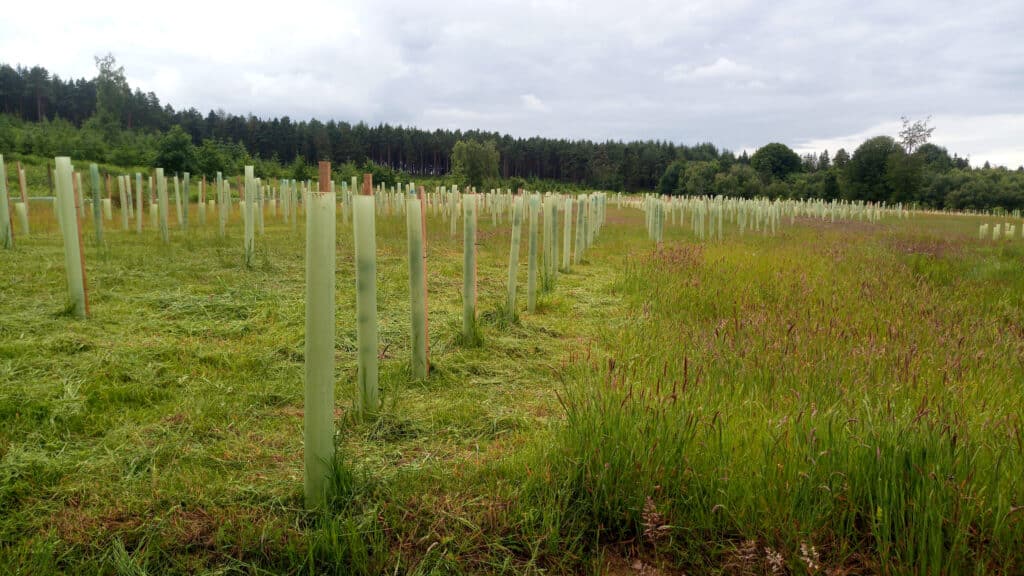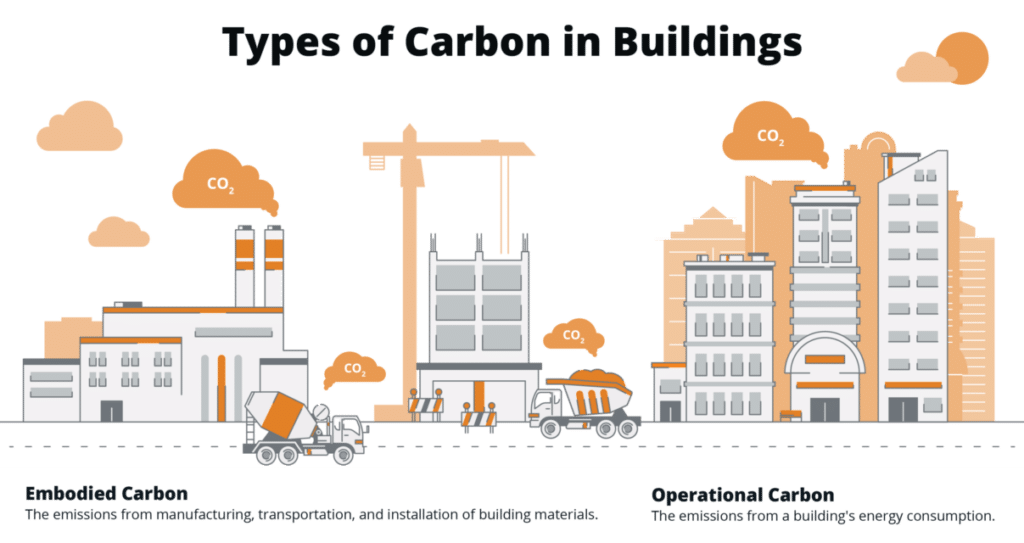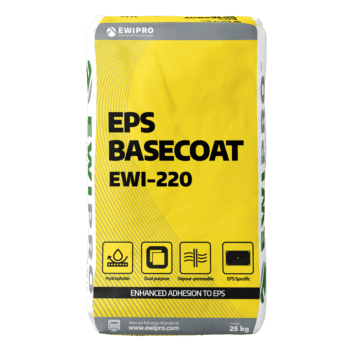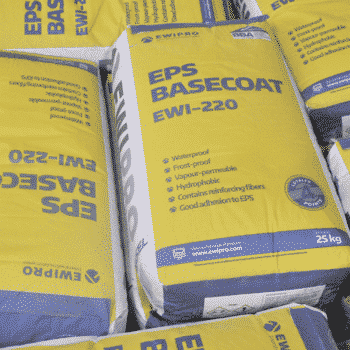How to Reduce Waste on Site
Waste is a persistent problem on building sites. However, conscious construction is growing and gaining popularity. The aim to reduce waste requires full site and client cooperation. There are several strategies to undertake in terms of materials and tools, but also in terms of offsetting carbon emissions and reducing embodied carbon. In this blog, we will discuss these strategies as well as suggest tools that can reduce waste on-site.
Materials to reduce waste
The effort of reducing waste always starts with the materials you select. An external wall insulation system requires a multitude of different materials, including basecoats, primers, insulation, fixings, renders, and more. However daunting that may initially sound, many materials can serve a dual purpose.
For instance, let us examine basecoats with a dual purpose. The secondary purpose of many EWI Store basecoats is their capability to work as adhesives for insulation boards. The premier options in this department include EWI-225 Premium Basecoat and EWI-220 EPS Basecoat.
-
Premium Basecoat (EWI-225) – 25kg
Rated 5.00 out of 5£20.90 Incl. VAT£17.42 Excl. VAT£23.23 Incl. VAT£19.36 Excl. VAT
Premium Basecoat is breathable, high strength and durable. EWI-225 is EWI Pro’s finest basecoat adhesive and is suitable for a range of solutions. For example, this product is ideal as a basecoat/adhesive for Mineral Wool, Kingspan K5 and Wood Fibre insulation boards, or as a render-only solution for a range of substrates, including render carrier board. The adhesive contains white Portland cement – making it stronger than other basecoat adhesives. Once the basecoat has dried it provides an incredibly strong and flexible reinforcement layer; we therefore highly recommend this product for ‘render only’ systems.
-
EPS Basecoat Adhesive (EWI-220) – 25kg
Rated 4.44 out of 5£14.52 Incl. VAT£12.10 Excl. VAT£16.16 Incl. VAT£13.47 Excl. VAT
Our most popular EPS-compatible basecoat. The major selling point of this particular product is its dual-purpose use. As it is also a bedding adhesive, only one type of product is required on-site. Therefore, there is less wastage on site and disposal is simple. Moreover, there is no confusion about water mix proportions or usability time, eliminating potential errors which affect performance.
In theory, our range of Silicone Renders also reduces waste on site. They already hold excellent hydrophobic qualities and are tinted to any colour, therefore do not require a coating of paint.
Tools to reduce waste
Another crucial asset to consider when thinking about reducing waste is the tools at your disposal. For example, you can infinitely reuse your render buckets for mixing and cleaning purposes. As such, they do not go to landfill. Many tools will also function with the same effect irrespective of whether you’re applying basecoats, adhesives, or render. Therefore, you only require a few hand tools on site, as opposed to highly specialised tools. However, the tools with the most impact in reducing waste are spray machines and EPS cutters.

Using EPS Cutters to Reduce Waste
Expanded Polystyrene (EPS) is a popular choice for insulation due to its excellent thermal resistance, lightweight, and versatility. But, as with any construction material, installing it can produce waste. EPS cutters are innovative tools that can help minimise this waste, making your insulation process more efficient and environmentally friendly. Here’s how:
Precision cutting
EPS cutters provide clean and precise cuts, which significantly reduces the amount of wasted material. Before EPS cutters, cutting EPS was a manual process that often resulted in irregularities, necessitating additional cuts and producing more waste. The precision of an EPS cutter means insulation pieces fit better and fewer pieces are discarded due to cutting errors. Crucially, cutting EPS with a saw produces a huge mess of polystyrene beads, which can be hazardous to health. A hot wire cutter removes that problem.
Customisable sizes
EPS cutters offer the flexibility to cut EPS insulation to the exact sizes needed for your specific project. This feature is particularly useful when insulating non-standard spaces or complex building designs where conventional insulation sizes may not be suitable. By having the ability to cut customised sizes, you can optimise the use of your EPS and decrease the amount of waste.
Efficient use of material
By producing precise cuts, EPS cutters enable maximum utilisation of each EPS sheet, which significantly reduces leftover material. Often, these machines are adjustable which minimises the kerf, or width of the cut. Therefore, less material is removed and wasted during the cutting process.
On-site adjustments
Having an EPS cutter on site also allows for adjustments to be made during the installation process. If a piece of insulation doesn’t fit perfectly, it is trimmed on-site, reducing the need for excess pieces and limiting the amount of waste generated.
Safety considerations
In addition to reducing waste, EPS cutters also have safety in mind. These machines often include features such as dust extraction and hot-wire cutting, which minimises the health risks associated with cutting insulation, such as respiratory problems and fire hazards.
https://www.youtube.com/watch?v=ItIFGgqxQcU
Spray machines
Precision and consistency
A major benefit of using spray machines for applying basecoats and renders is the level of precision and consistency they offer. These machines can deliver an even coat across large surfaces and into tight corners, which is often challenging with manual application methods. By ensuring a consistent thickness, spray machines eliminate the excess material that results from over-application, significantly reducing waste.
Speed and efficiency
Spray machines can apply basecoats and render much faster than traditional manual methods, saving valuable time on site. With quicker application times, the potential for the material to dry out or become unusable before it can be applied is minimised, thereby reducing waste. In addition, a faster application process means fewer interruptions, which can further decrease the likelihood of material waste.
Reduced material handling
Spray machines often mix the basecoat or render material right at the point of application. This feature reduces the need for extensive on-site material handling and storage, decreasing the risk of damage or contamination to the materials before use. This results in a substantial reduction in material waste compared to traditional methods.
Tailored application
With adjustable settings, spray machines can be customised to apply the precise amount of material required for a specific surface or project. This means that the exact amount of basecoat or render needed can be applied without overuse or wastage.
Recycling excess material
Some advanced spray machines have a reclamation system that can recycle excess material. This means any basecoat or render that is not applied to the surface can be collected, cleaned, and reused, further reducing waste.
Less cleanup
Finally, using a spray machine often results in less mess compared to manual methods. Less material is spilt or splattered, reducing the amount of cleanup required and, by extension, the waste produced.
https://www.youtube.com/watch?v=5KtH8GMDCLs
Preparation is key
As with most projects, preparation ensures correct delivery. This is true in terms of reducing waste. It all begins with organising a professional site survey to assess the correct solution. Our sister company, EWI Pro, offers site surveys wherein our representatives will visit the site and recommend the type and amount of materials required. As a result, you won’t over-order materials, leading to less wastage. If the site is surveyed correctly and provisions for storage are made, the whole system materials can be ordered in bulk. As a result, the transportation costs and carbon footprint is far lower. The process of lowering embodied carbon and offsetting carbon emissions is integral to any conscious construction project.
Carbon offsetting involves compensating for the emission of carbon dioxide (CO2) and other greenhouse gases produced by a particular process or project. This is typically done by funding equivalent carbon dioxide-saving projects elsewhere. These offset projects could include renewable energy installations, tree planting, or energy efficiency initiatives.
For external wall insulation and render projects, carbon offsetting may involve investing in projects that absorb or prevent the emission of a quantity of CO2 equivalent to the emissions produced during the manufacture, transportation, and installation of the insulation and render materials.

Embodied carbon refers to the carbon emissions produced during the life cycle of a material, including its extraction, manufacturing, transportation, installation, and disposal.
In the context of external wall insulation and render projects, the embodied carbon would encompass the emissions produced from the extraction of raw materials, manufacture of insulation and render, their transportation to the construction site, the installation process, and the eventual disposal or recycling of these materials at the end of the building’s life.

How do you reduce waste on site? Let us know below!
Facebook
Twitter
LinkedIn
Your cart
Trade Account Login

We use cookies on our website to give you the most relevant experience by remembering your preferences and repeat visits. By clicking “Accept All”, you consent to the use of ALL the cookies. However, you may visit "Cookie Settings" to provide personalised consent.
Manage consent
Privacy Overview
This website uses cookies to improve your experience while you navigate through the website. Out of these, the cookies that are categorized as necessary are stored on your browser as they are essential for the working of basic functionalities of the website. We also use third-party cookies that help us analyze and understand how you use this website. These cookies will be stored in your browser only with your consent. You also have the option to opt-out of these cookies. But opting out of some of these cookies may affect your browsing experience.
Necessary cookies are absolutely essential for the website to function properly. These cookies ensure basic functionalities and security features of the website, anonymously.
| Cookie | Duration | Description |
|---|---|---|
| __stripe_mid | 1 year | This cookie is set by Stripe payment gateway. This cookie is used to enable payment on the website without storing any patment information on a server. |
| __stripe_sid | 30 minutes | This cookie is set by Stripe payment gateway. This cookie is used to enable payment on the website without storing any patment information on a server. |
| _GRECAPTCHA | 5 months 27 days | This cookie is set by the Google recaptcha service to identify bots to protect the website against malicious spam attacks. |
| apbct_cookies_test | session | CleanTalk sets this cookie to prevent spam on comments and forms and act as a complete anti-spam solution and firewall for the site. |
| apbct_page_hits | session | CleanTalk sets this cookie to prevent spam on comments and forms and act as a complete anti-spam solution and firewall for the site. |
| apbct_prev_referer | session | Functional cookie placed by CleanTalk Spam Protect to store referring IDs and prevent unauthorized spam from being sent from the website. |
| apbct_site_landing_ts | session | CleanTalk sets this cookie to prevent spam on comments and forms and act as a complete anti-spam solution and firewall for the site. |
| apbct_site_referer | 3 days | This cookie is placed by CleanTalk Spam Protect to prevent spam and to store the referrer page address which led the user to the website. |
| apbct_timestamp | session | CleanTalk sets this cookie to prevent spam on comments and forms and act as a complete anti-spam solution and firewall for the site. |
| apbct_urls | 3 days | This cookie is placed by CleanTalk Spam Protect to prevent spam and to store the addresses (urls) visited on the website. |
| AWSALBCORS | 7 days | This cookie is managed by Amazon Web Services and is used for load balancing. |
| cookielawinfo-checkbox-advertisement | 1 year | Set by the GDPR Cookie Consent plugin, this cookie is used to record the user consent for the cookies in the "Advertisement" category . |
| cookielawinfo-checkbox-analytics | 11 months | This cookie is set by GDPR Cookie Consent plugin. The cookie is used to store the user consent for the cookies in the category "Analytics". |
| cookielawinfo-checkbox-functional | 11 months | The cookie is set by GDPR cookie consent to record the user consent for the cookies in the category "Functional". |
| cookielawinfo-checkbox-necessary | 11 months | This cookie is set by GDPR Cookie Consent plugin. The cookies is used to store the user consent for the cookies in the category "Necessary". |
| cookielawinfo-checkbox-others | 11 months | This cookie is set by GDPR Cookie Consent plugin. The cookie is used to store the user consent for the cookies in the category "Other. |
| cookielawinfo-checkbox-performance | 11 months | This cookie is set by GDPR Cookie Consent plugin. The cookie is used to store the user consent for the cookies in the category "Performance". |
| ct_checkjs | session | CleanTalk–Used to prevent spam on our comments and forms and acts as a complete anti-spam solution and firewall for this site. |
| ct_fkp_timestamp | session | CleanTalk sets this cookie to prevent spam on the site's comments/forms, and to act as a complete anti-spam solution and firewall for the site. |
| ct_pointer_data | session | CleanTalk sets this cookie to prevent spam on the site's comments/forms, and to act as a complete anti-spam solution and firewall for the site. |
| ct_ps_timestamp | session | CleanTalk sets this cookie to prevent spam on the site's comments/forms, and to act as a complete anti-spam solution and firewall for the site. |
| ct_sfw_pass_key | 1 month | CleanTalk sets this cookie to prevent spam on comments and forms and act as a complete anti-spam solution and firewall for the site. |
| ct_timezone | session | CleanTalk–Used to prevent spam on our comments and forms and acts as a complete anti-spam solution and firewall for this site. |
| elementor | never | This cookie is used by the website's WordPress theme. It allows the website owner to implement or change the website's content in real-time. |
| viewed_cookie_policy | 11 months | The cookie is set by the GDPR Cookie Consent plugin and is used to store whether or not user has consented to the use of cookies. It does not store any personal data. |
Functional cookies help to perform certain functionalities like sharing the content of the website on social media platforms, collect feedbacks, and other third-party features.
| Cookie | Duration | Description |
|---|---|---|
| __zlcmid | 1 year | This cookie is used by Zendesk live chat and is used to store the live chat ID. |
| bcookie | 2 years | LinkedIn sets this cookie from LinkedIn share buttons and ad tags to recognize browser ID. |
| bscookie | 2 years | LinkedIn sets this cookie to store performed actions on the website. |
| lang | session | LinkedIn sets this cookie to remember a user's language setting. |
| lidc | 1 day | LinkedIn sets the lidc cookie to facilitate data center selection. |
| UserMatchHistory | 1 month | LinkedIn sets this cookie for LinkedIn Ads ID syncing. |
Performance cookies are used to understand and analyze the key performance indexes of the website which helps in delivering a better user experience for the visitors.
| Cookie | Duration | Description |
|---|---|---|
| __utma | 2 years | This cookie is set by Google Analytics and is used to distinguish users and sessions. The cookie is created when the JavaScript library executes and there are no existing __utma cookies. The cookie is updated every time data is sent to Google Analytics. |
| __utmb | 30 minutes | Google Analytics sets this cookie, to determine new sessions/visits. __utmb cookie is created when the JavaScript library executes and there are no existing __utma cookies. It is updated every time data is sent to Google Analytics. |
| __utmc | session | The cookie is set by Google Analytics and is deleted when the user closes the browser. It is used to enable interoperability with urchin.js, which is an older version of Google Analytics and is used in conjunction with the __utmb cookie to determine new sessions/visits. |
| __utmt | 10 minutes | Google Analytics sets this cookie to inhibit request rate. |
| __utmv | 2 years | The __utmv cookie is set on the user's device, to enable Google Analytics to classify the visitor. |
| __utmz | 6 months | Google Analytics sets this cookie to store the traffic source or campaign by which the visitor reached the site. |
| sib_cuid | 6 months | Purechat uses this cookie to send data to purechat.com, to connect visitors to the reservation team and track visitors to stay on portal. |
| SRM_B | 1 year 24 days | Used by Microsoft Advertising as a unique ID for visitors. |
Analytical cookies are used to understand how visitors interact with the website. These cookies help provide information on metrics the number of visitors, bounce rate, traffic source, etc.
| Cookie | Duration | Description |
|---|---|---|
| _ga | 2 years | The _ga cookie, installed by Google Analytics, calculates visitor, session and campaign data and also keeps track of site usage for the site's analytics report. The cookie stores information anonymously and assigns a randomly generated number to recognize unique visitors. |
| _gat_gtag_UA_61069204_2 | 1 minute | Set by Google to distinguish users. |
| _gat_UA-61069204-2 | 1 minute | A variation of the _gat cookie set by Google Analytics and Google Tag Manager to allow website owners to track visitor behaviour and measure site performance. The pattern element in the name contains the unique identity number of the account or website it relates to. |
| _gcl_au | 3 months | Provided by Google Tag Manager to experiment advertisement efficiency of websites using their services. |
| _gid | 1 day | Installed by Google Analytics, _gid cookie stores information on how visitors use a website, while also creating an analytics report of the website's performance. Some of the data that are collected include the number of visitors, their source, and the pages they visit anonymously. |
| _uetsid | 1 day | This cookies are used to collect analytical information about how visitors use the website. This information is used to compile report and improve site. |
| CONSENT | 2 years | YouTube sets this cookie via embedded youtube-videos and registers anonymous statistical data. |
Advertisement cookies are used to provide visitors with relevant ads and marketing campaigns. These cookies track visitors across websites and collect information to provide customized ads.
| Cookie | Duration | Description |
|---|---|---|
| _fbp | 3 months | This cookie is set by Facebook to display advertisements when either on Facebook or on a digital platform powered by Facebook advertising, after visiting the website. |
| ANONCHK | 10 minutes | The ANONCHK cookie, set by Bing, is used to store a user's session ID and also verify the clicks from ads on the Bing search engine. The cookie helps in reporting and personalization as well. |
| fr | 3 months | Facebook sets this cookie to show relevant advertisements to users by tracking user behaviour across the web, on sites that have Facebook pixel or Facebook social plugin. |
| MUID | 1 year 24 days | Bing sets this cookie to recognize unique web browsers visiting Microsoft sites. This cookie is used for advertising, site analytics, and other operations. |
| NID | 6 months | NID cookie, set by Google, is used for advertising purposes; to limit the number of times the user sees an ad, to mute unwanted ads, and to measure the effectiveness of ads. |
| test_cookie | 15 minutes | The test_cookie is set by doubleclick.net and is used to determine if the user's browser supports cookies. |
| uuid | 6 months | MediaMath sets this cookie to avoid the same ads from being shown repeatedly and for relevant advertising. |
| VISITOR_INFO1_LIVE | 5 months 27 days | A cookie set by YouTube to measure bandwidth that determines whether the user gets the new or old player interface. |
| YSC | session | YSC cookie is set by Youtube and is used to track the views of embedded videos on Youtube pages. |
| yt-remote-connected-devices | never | YouTube sets this cookie to store the video preferences of the user using embedded YouTube video. |
| yt-remote-device-id | never | YouTube sets this cookie to store the video preferences of the user using embedded YouTube video. |
| yt.innertube::nextId | never | This cookie, set by YouTube, registers a unique ID to store data on what videos from YouTube the user has seen. |
| yt.innertube::requests | never | This cookie, set by YouTube, registers a unique ID to store data on what videos from YouTube the user has seen. |
Other uncategorized cookies are those that are being analyzed and have not been classified into a category as yet.
| Cookie | Duration | Description |
|---|---|---|
| _clck | 1 year | No description |
| _clsk | 1 day | No description |
| _uetvid | 1 year 24 days | No description available. |
| AnalyticsSyncHistory | 1 month | No description |
| apbct_pixel_url | session | No description |
| apbct_visible_fields_0 | session | No description |
| apbct_visible_fields_1 | session | No description |
| apbct_visible_fields_10 | session | No description |
| apbct_visible_fields_2 | session | No description |
| apbct_visible_fields_3 | session | No description |
| apbct_visible_fields_4 | session | No description |
| apbct_visible_fields_5 | session | No description |
| apbct_visible_fields_6 | session | No description |
| apbct_visible_fields_7 | session | No description |
| apbct_visible_fields_8 | session | No description |
| apbct_visible_fields_9 | session | No description |
| ct_checked_emails | session | No description |
| ct_has_scrolled | session | No description |
| ct_mouse_moved | session | No description |
| ct_screen_info | session | No description |
| ictf_master | never | No description available. |
| li_gc | 2 years | No description |
| m | 2 years | No description available. |
| SM | session | No description available. |
| testinfinitycookie | session | No description |
| woocommerce_show_tax | 7 days | No description available. |
| wp_woocommerce_session_c5ac76b408021294cb56bcc27eddf8a1 | 2 days | No description |




